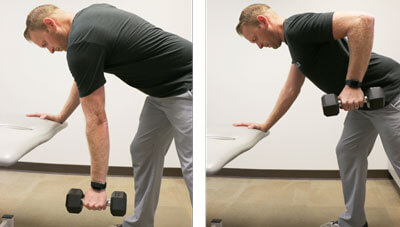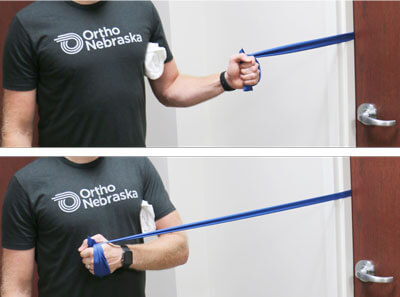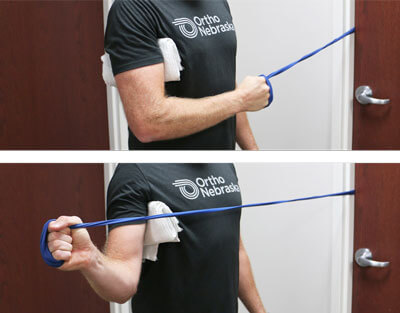12/18/2020
Returning to a weight lifting routine after a shoulder injury is always a hot topic.
Multiple muscles attach at the shoulder, so achieving balance in a strengthening program is very important.
Here are some tips and tricks that can reduce the risk for re-injury:
-
- Remember the 1:2 ratio
For every chest/pressing exercise completed (bench press, incline press, push-ups, etc.), perform 2 back/shoulder blade exercises to maintain balance. The goal is to strengthen muscles at the shoulder blade. Examples include: bent over shoulder extensions, reverse flys, and the bent over row.
- Remember the 1:2 ratio
Featured Exercise: Bent Over Row

Leaning against a bed or counter, slowly raise your arm upward while bending your elbow. Squeeze your shoulder blades towards your spine. Repeat for 3 sets of 10 reps with a 3-5 lb weight, or whatever you can easily tolerate.
-
- Strengthen the rotator cuff muscles.
Featured Exercise: Internal Rotation

Place a towel roll between your side and upper arm. While holding an elastic band at your side with your elbow bent, start with your hand away from your stomach, then pull the band towards your stomach. Keep your elbow near your side the entire time. Repeat for 3 sets of 10-15 reps.
Featured Exercise: External Rotation

Place a towel roll between your side and upper arm (as shown). While holding an elastic band at your side with your elbow bent, start with your hand near your stomach and then pull the band away. Keep your elbow at your side the entire time. Repeat for 3 sets of 10 reps.
- Watch your hands.
When performing any pressing activity or an overhead lift, you need to be able to see your hands within your peripheral vision. - One thing at a time.
When attempting new exercises, try adding one new exercise at a time. That way if you become excessively sore or have pain, you know what caused it. - Take it slow.
When progressing your exercises, first increase repetitions and sets before increasing the weight. - Pay attention to your posture.
Maintain a neutral spine and avoid slouching. - Listen to your body.
If you feel discomfort or pain stop. Allow it to rest for a day or so to calm things down before starting back up. If the discomfort persists it is recommended to have a professional assessment and make sure there is no further injury. At OrthoNebraska, we make this easy, with walk-in Orthopedic Urgent Care and shoulder specialists.
The shoulder is designed for mobility which allows us to do many highly skilled activities such as throwing a baseball 98 mph or swimming the backstroke. With so much movement in the shoulder, it is important to avoid high levels of strain at extreme ranges of motion as well as keep the rotator cuff strong. Reduce the risk of re-injury by making a few small changes to your workout routine. You will be glad you did.
Need help with a shoulder injury or have a question? Ask a therapist or call (402) 609-1750.


